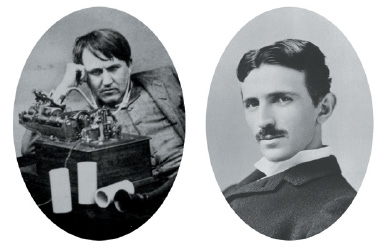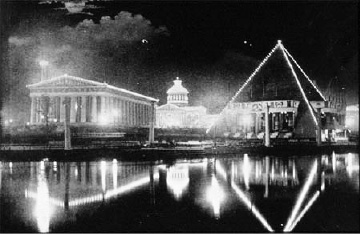Chapter Seven
Battle of the Currents

Thomas Edison (left) and Nikola Tesla (right).
AC or DC? That sounds like a simple question. But amazingly, determining the answer to this scientific question would spark a furious feud between two of the greatest inventors of the 19th century Electrical Age: Nikola Tesla and Thomas Edison. These scientific squabblers actually started out regarding each other with great respect.
Tesla, a gifted Serbian engineer, came to Manhattan in 1884 to meet Thomas Edison, the inventor of the light bulb, about whom he’d read so much. Tesla’s inventions would eventually include the neon light, a wireless radio transmission, a submarine that was guided by remote control, and a guided missile system. Edison had risen to become one of the most famous and accomplished inventors of the day, even described in the press as the greatest genius of the modern age. When Edison met Tesla in New York in 1884, he was so impressed with him that he hired him on the spot.
For a while the two inventors worked together, designing generators and other electrical devices for Edison’s new electric company. But their early friendship dissolved—some say in a dispute over money. Tesla claimed that Edison has promised him a bonus if he could make the company’s dynamos work more efficiently—but then claimed that he’d only been joking after Tesla succeeded. Edison’s friends claimed that Tesla was at fault: he was too interested in his own ideas for machines that were not compatible with the Edison system. Whatever happened, the two men began to quarrel. Finally, Tesla quit, vowing to start a business of his own.
The tension between Edison and Tesla may have started simply because the two men were really opposites in every way. While Edison was self-taught and “street smart,” Tesla was scholarly and bookish. Edison liked to work with his hands, but Tesla preferred to think out ideas in his head. Edison experimented by a process of trail-and-error; Tesla, by working out long calculations. The two men were even physical opposites. Edison was short and portly and Tesla was tall and handsome. Edison’s clothes were often sloppy, but Tesla was always immaculately dressed. In every way, Tesla and Edison were technology’s “odd couple.”
It’s no surprise, then, that these two inventors also held opposite views about electric current. Edison favored direct current. “DC” is simple to operate, but it can travel only for short distances, requiring power stations every few blocks. Tesla had developed a new system, called “polyphase alternating current,” or “AC” for short. AC is more complicated than DC, but it can travel much farther. For example, flashlights work on DC, and their current runs one way, from the battery to the bulb and back. But a house runs on AC, and its current actually changes directions 60 times or cycles every second. AC is better for powering a city because it can run over thin copper wires, but DC requires thicker wires, which cost much more. In just a few years, Tesla’s alternating current would revolutionize the world. His AC power plants would even harness Niagara Falls to bring electric power to cities many miles away.
But Edison continued to use DC, and the he tried to convince the public that AC was dangerous. He argued that houses wired to AC current might catch fire, and warned people against walking near AC street poles. He even arranged to have AC used to power the world’s first electric chair, perhaps to demonstrate that if AC could be used to kill condemned criminals, then it might kill regular people as well.
Tesla, in turn, scoffed at Edison’s work, saying, “If Thomas Edison had to find a needle in a haystack, he would examine each straw instead of finding a smarter way.” Rivals usually just fight it out. But these two geniuses turned their feud into a “race of progress.” When Edison created a new kind of telephone, Tesla built the most powerful steam engine in the world. Edison invented the prefabricated house, but Tesla designed vacuum tubes that would pave the way for television. Edison amazed the public with the first movie studio; Tesla designed a machine that produced showers of artificial lightning. For the rest of their lives, Edison—the Wizard of Menlo Park—would duel with Tesla—the “Master of Lightning” and creator of the tesla coil—to see which man was the world’s greatest inventor.
The one thing these two geniuses could never invent was a way to end their feud. In 1910, Tesla developed an advanced turbine that could have helped Edison’s firm. But the two men didn’t trust each other, and the invention was never used. Then a prestigious engineering society sought to honor Tesla. The bad news? The prize had been named the Edison Medal. “You would be honoring Edison with that prize!” Tesla roared. On award night, Tesla actually sat outside the hall and fed the pigeons, until frantic event organizers finally convinced him to come inside and accept the medal. And when newspapers reported that Edison and Tesla had been nominated as co-recipients of the Nobel Prize in Physics, there was been talk that they might both decline it, rather than accept the award together. But since the award committee selected two other scientists instead, no one will ever know how Edison and Tesla might have handled the award.

A display of electric lights at the 1897 Tennessee Centennial Exposition
So who finally won the “shocking” battle between Tesla and Edison? Some say that Tesla won, because we use his AC system today. Others say that Edison won because he collected more patents, earned more money, and became more famous. In fact, historians and biographers are still quarreling over which of these inventors made the greatest innovations. So in a way, the feud between Tesla and Edison is still going on.
Both were extraordinary innovators, and they simply approached technology in opposite ways. Edison liked simple, practical ideas. As an amazing example, he built the first phonograph in just a few days, and had a commercial model ready for sale a few weeks later. In contrast, Tesla thought more about the future. Some of his experiments from the 1890s actually helped modern engineers invent the cell phone. Of course, technology depends on both short-term and long-term thinking. So you could say that these geniuses were both winners in their own way.
Today when you turn on Thomas Edison’s fantastic invention, the light bulb, it’s Nikola Tesla’s remarkable AC power that makes that bulb glow. Two great ideas, from two great inventors—this time working together. What a brilliant idea!